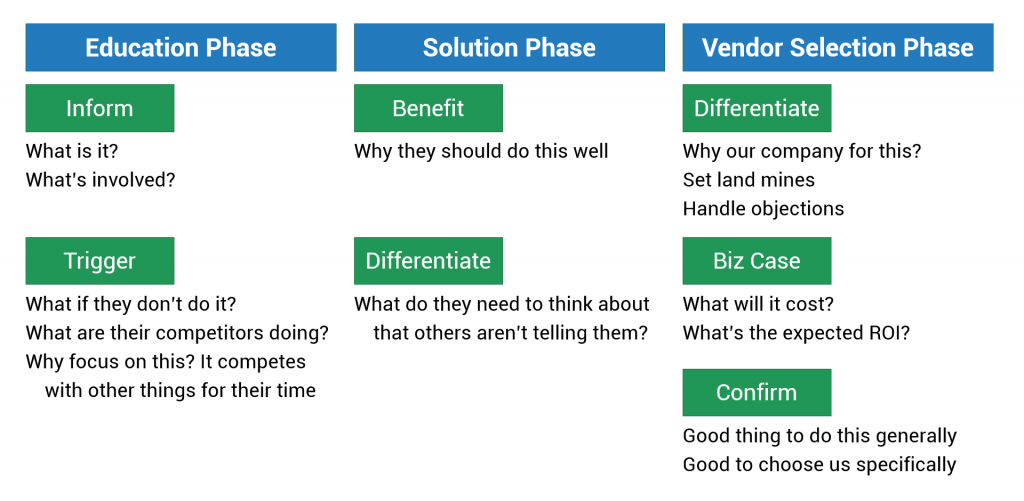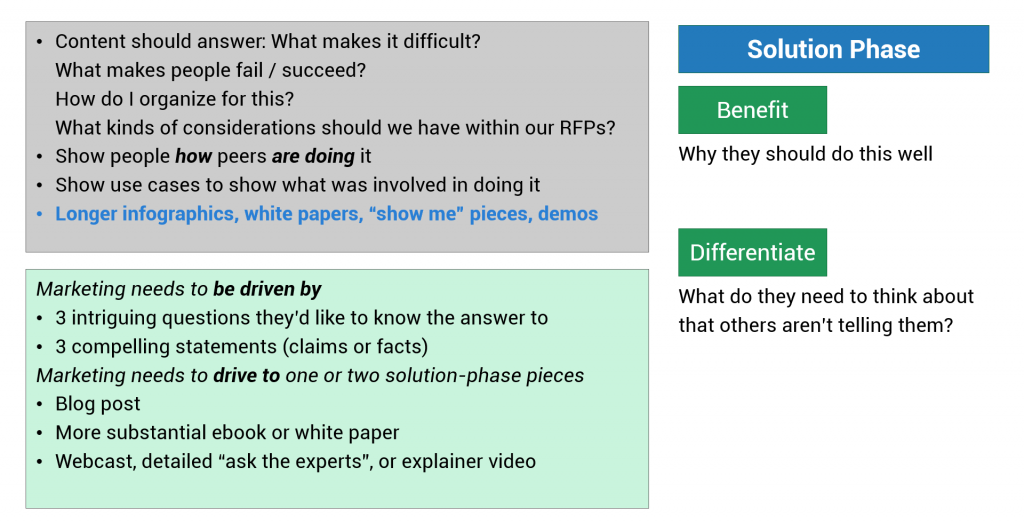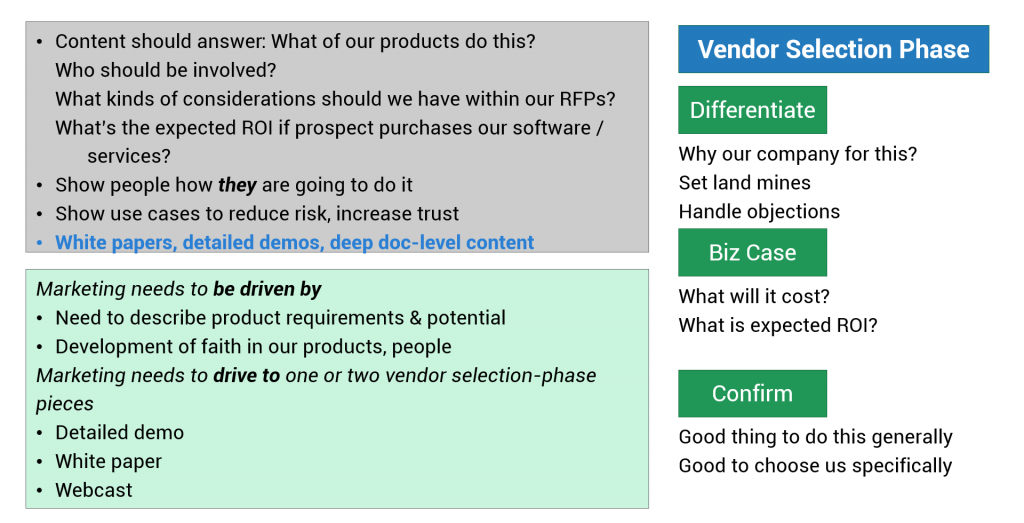
In an earlier post, we looked at the sales funnel, because marketing and sales should align. Now I’d like to zoom out a little bit. The sales funnel comprises the latter half of the buyer’s journey but as marketers, we need to consider the whole journey.
A quick search identifies many different models of the buyer’s journey. I adopted this model from I-forget-where. Feel free to develop your own model — consider this post as a starting point for creating an adaptable content strategy for your particular buyer’s journey.
The Buyer’s Journey

I divide the buyer’s journey into three high-level phases: Education, Solution, and Vendor Selection. It’s often hard to target more narrowly than these phases, and this level of discussion often works best when aligning with sales, customer support, and marketing staff.
This three-phase approach works well to:
- Align marketing messages and outreach with sales SMEs
- Tap into sales and customer support knowledge about what leads to successful opportunities – inviting them to help identify key questions and compelling statements of customer value
- Align collateral and campaigns more effectively with the buyer’s journey
On the other hand, it helps to think with a little more subtlety. Even if my content and outreach don’t differentiate personas more finely than these three phases, my content strategy subdivides each phase into two parts, for a total of six – though “Differentiate” really straddles the line between the Solution and Vendor Selection phases.
Once you decide how to address the buyer’s journey, you can break your content requirements down based on what questions your content must answer and what issues it’s raising. I tend to line my large-scale phases, sub-phases, and questions/concepts like this:

The phases of the buyer’s journey, broken out according to the kinds of questions your content strategy should be answering.
Number of phases aside, your content strategy should move content from one phase to the next.
Education Phase
When prospective buyers first start to learn about potential solutions, they’re looking for definitions and answers to basic questions.
Your content should provide that information but also trigger buyers to take action now. They already have serious demands competing for their time, and it’s important to cultivate a sense of urgency for taking action now.
One potential way to organize content strategy during the education phase is listed in the chart below. Note that I emphasize different issues related to peers in each phase; you might consider this in the light of the earlier Customer Successes blog post.

Questions, considerations, and possible marketing guidance for the Education Phase.
Solution Phase
Once buyers realize that they need to take action, they begin to evaluate available solutions. The solution phase should include the all important marketing staple: benefits. Take the time to map your product and service features into benefits.
This phase also presents the perfect time to differentiate your type of solution against other types. I caution against pitching your specific solution just yet.
People are naturally wary of sales pitches and in this phase, they’re looking for objective thought leadership content. Pace the content to present a reasoned argument about important issues, focusing specifically on the issues that motivated your company to develop and deliver the solutions it offers.
Engage closely with product marketing (and/or product management, depending on your company), because those product owners understand the justification for the solutions your company builds and sells.
This kind of differentiation is one of my favorite uses for third-party content because it can objectively provide solution knowledge and customer case studies that help drive prospective customers forward on their journey.

Questions, considerations, and possible marketing guidance for the Solution Phase.
Vendor Selection Phase
Differentiation continues in the vendor selection phase, when prospective customers are evaluating multiple vendors. Content becomes critical here, because it must communicate why your company and the solutions it provides are the right choice. The messaging must explain why your solution is better than your competition’s solutions. Marketing professionals accurately refer to this strategy as “setting land mines.” You must also handle land mines your competitors may set for you.
To finish the job and close the deal, you must present a strong business case and confirm that prospective customers’ decision to choose your company and solution is the right choice. Yes, it’s still a good idea; yes, they’ll successfully implement and benefit from the vision you’ve presented throughout their buyer’s journey.

Questions, considerations, and possible marketing guidance for the Vendor Selection Phase.
Your requirements might differ, and that’s okay. I’m a big fan of adapting ideas to your own needs rather than over stressing about following a prescription. I hope these ideas have given you some of the tools you need to consider a content strategy for thought leadership during each phase of the buyer’s journey.
